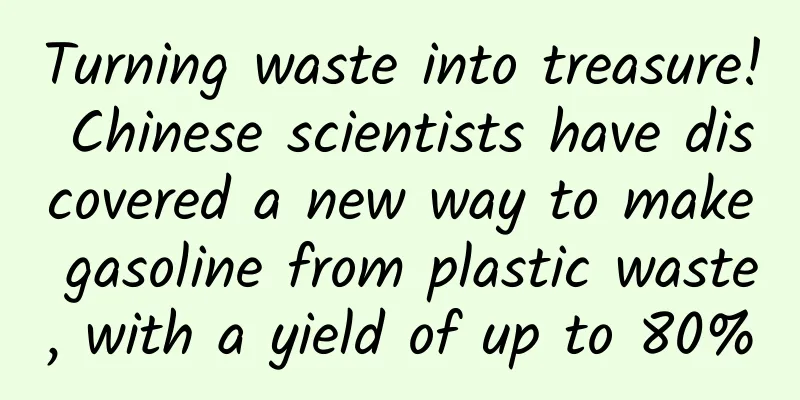Turning waste into treasure! Chinese scientists have discovered a new way to make gasoline from plastic waste, with a yield of up to 80%

|
Polyethylene plastics are everywhere in our daily lives, from lightweight shopping bags to durable food packaging bags, from fashion clothing to building materials. Its wide application has greatly facilitated people's life needs. Along with it, there is a problem that cannot be ignored - the pollution of waste plastics to the environment. People's dependence on the use of disposable plastic products has led to a large amount of discarded polyethylene plastics being discarded in the natural environment. These plastic wastes are difficult to degrade. While polluting the environment, they also threaten the survival of wild animals and plants, and even indirectly affect human health through the food chain. In the long run, it will have a negative impact on the soil, water sources and ecosystems that cannot be ignored. So, how can we achieve environmentally friendly recycling and reuse of waste polyethylene plastics? Copyright images in the gallery. Reprinting and using them may lead to copyright disputes. On April 9, 2024, Chinese scientists published an article in the journal Nature Chemistry on the recycling of polyethylene to produce high-quality gasoline, which is expected to achieve efficient utilization of waste polyethylene plastics. The research results were published in the journal Nature Chemistry. Image source: Nature Chemistry Transforming polyethylene plastic into high-quality gasoline The resource utilization of waste plastics can not only solve the problem of environmental pollution, but also achieve sustainable development of resources. Among the waste plastics, polyethylene is very difficult to convert, and its non-polar "carbon-carbon bond" is difficult to activate and break under low temperature conditions. At present, the main strategy for converting polyethylene is to achieve it under high reaction temperature (above 400°C), precious metal catalysts and external hydrogen sources. The strict reaction conditions limit the application of industrial recycling of polyethylene. Based on the problems faced in the catalytic conversion of polyethylene, the researchers used tetrabutylammonium hydroxide (C16H37NO) as a structure-directing agent and adopted a "one-step hydrothermal reaction" to synthesize a molecular sieve with a layered self-supporting structure (LSP) for the catalytic conversion of polyethylene. Among them, structure-directing agents, by adding specific ligands or additives in chemical reactions during crystal synthesis or growth, guide the molecular assembly to form a highly crystallized ordered structure with ideal physical and chemical properties. Layered self-supporting structures (LSPs) are formed by cations and anions bonded together through ionic bonds, and have sufficient strength and stability to exist independently without additional support. Mesoporous channels are between micropores and macropores, with a pore size between 2-50Nm, and have a highly ordered structure and rich surface activity, which plays an important role in catalyst performance. Layered self-supporting molecular sieves have a larger specific surface area and rich mesoporous channels, which can make the reactants fully contact the catalyst in the catalytic reaction and increase the reaction rate. Compared with traditional molecular sieve materials, it has a unique self-supporting structure and more strong Lewis acid sites. Lewis acid sites are a chemical substance that can accept electrons at specific locations (or regions) and achieve catalysis by adsorbing and activating reactants. The strong Lewis acid sites in the molecular sieve and its shape selectivity can play a key role in catalyzing the conversion of polyethylene. Therefore, the layered self-supporting molecular sieve can better catalyze the conversion of polyethylene. Characterization of the catalyst (a. High-resolution transmission electron microscopy; b. X-ray diffraction; c. Nitrogen adsorption-desorption isotherm; d, e. NMR characterization results; f, g. IR characterization results). Image source: Reference [1] Gasoline is mainly composed of hydrocarbons in the C4-C12 range, which is a mixture of alkanes, alkenes and cycloalkanes. The octane number is a numerical indicator to measure the anti-knock ability of gasoline in the cylinder, and is usually used to evaluate the performance of automotive gasoline, that is, the quality of gasoline. Copyright images in the gallery. Reprinting and using them may lead to copyright disputes. The experimental results show that the layered self-supporting molecular sieve (LSP-Z100) prepared in this study can achieve the conversion from high-density polyethylene to gasoline in 4 hours at a temperature of 240°C and without an external hydrogen source, with a yield of up to 80%. By detecting its liquid phase product, the C4-C12 component accounts for up to 99%, and the branched alkane accounts for 72%, with a high octane number (88.0), comparable to the octane number of commercial gasoline (86.6). The above results show that the layered self-supporting molecular sieve (LSP-Z100) has the feasibility of catalytically converting polyethylene into high-quality gasoline. This study provides a new thinking path for solving the environmental pollution problem of waste polyethylene plastics and how to effectively realize resource utilization. Conversion rate and product yield of high-density polyethylene under different catalyst conditions. Image source: Reference [1] When we think about the pollution caused by discarded plastics to the environment, starting with the little things we do ourselves is the beginning of our contribution to environmental protection. Reduce the use of unnecessary plastic products in daily life (such as disposable straws, plastic bags and tableware) to promote the improvement of social environmental awareness. Garbage classification is also a key link. Separate recyclable plastics from other garbage to reduce the chance of polyethylene entering the natural environment and promote the recycling of various resources. Ecological civilization is everyone's responsibility. Copyright images in the gallery. Reprinting and using them may lead to copyright disputes. References [1] Cen, Z., Han, X., Lin, L. et al. Upcycling of polyethylene to gasoline through a self-supplied hydrogen strategy in a layered self-pillared zeolite[J]. Nature Chemistry, 2024. [2] Xie Yufei, Wang Qi, Zeng Junmin, et al. Research progress in recycling and application of waste polyethylene plastics[J]. Plastics Science and Technology, 2022. [3] Zhang Jinqing, Guo Ming, Zhang Yuanwen, et al. Research progress in the production of fuel from cracking of waste polyethylene plastics[J]. Petrochemical Technology, 2022. [4] Gautam KR .A Novel Process of Converting Polyethylene to Gasoline, Middle Distillate and Heavy Oil through Hydropyrolysis Route[J].International Journal of Energy Engineering, 2013. Planning and production Produced by Science Popularization China Author: Shi Chang, PhD in Physical Chemistry Producer丨China Science Expo Editor: Dong Nana Proofread by Xu Lailinlin |
<<: How are those people who got eyeliner tattoos doing now?
>>: The mosquito repellent toilet water also needs a pesticide "license"
Recommend
The latest guide to self-recommended apps on the Apple App Store, first come first served for high traffic!
In the App Store of iOS 11, the menu at the botto...
"Air taxis" are here! Can we take a flying taxi when we go out in the future?
In Shanghai, I get off work at 6pm and go to Yang...
A gathering of young people with literary talents, Hammer has these three considerations
On the evening of the 19th, Hammer officially rel...
6 ways to increase user activity!
How to maintain and increase activity and improve...
With these new ways to play H5, are you still worried about running out of inspiration?
Understand the new capabilities and gameplay brou...
If you fast for 16 hours, your body will eat itself?! The human body's autophagy function is not that simple
Author: Ye Shi Popular Science Creator Reviewer: ...
What will happen to your body if you drink a cup of soy milk every day? Don't drink one of these, it will cause poisoning!
Soy milk is a popular healthy drink and is also k...
Analyzing the hot-selling machine - the community ecology of Toutiao
As one of ByteDance's popular apps, Toutiao i...
The barbarian Apple won the Oscar. How long will it take for streaming media companies to completely replace traditional film studios?
If it weren't for the Oscar winner Will Smith...
Another controversy! Should we "walk on the left and stand on the right" when taking an escalator? Here comes the scientific explanation
Recently, a netizen from Xi'an said that when...
Zhang Xudong: Only when the black soil is darker can we eat better
If we cannot ensure the continued production of N...
What are the main methods of Internet marketing and which ones are the most effective?
Nowadays, any company must do marketing and promo...
Ford F-150 hybrid version does not provide EV mode, endurance becomes a bottleneck
Recently, overseas media reported that Ford CTO (...
New US President's policy: Apple and Intel will have a hard time in China
According to CNNMoney, a financial website under ...
Apple's new iPhone production this year is 65 million, the lowest in four years
At 1 a.m. Beijing time on September 11, Apple wil...









